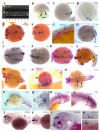Isolation and expression analysis of foxj1 and foxj1.2 in zebrafish embryos
- PMID: 18956329
- PMCID: PMC2587226
- DOI: 10.1387/ijdb.072477ea
Isolation and expression analysis of foxj1 and foxj1.2 in zebrafish embryos
Abstract
In this report, we present the isolation and identification of a zebrafish homolog of the winged helix\forkhead transcription factor Foxj1. Foxj1 was identified in other species but not in zebrafish. Foxj1 was shown in mice to be required in ciliogenesis and left-right asymmetry establishment. Here we present a spatio-temporal expression pattern of zebrafish foxj1, showing that this gene is expressed in dorsal forerunner cells, Kupffers vesicle, the floor plate, pronephric ducts and kidney. This expression pattern is overlapping but different from that of the foxj1.2, the closest related gene in zebrafish. Foxj1 in zebrafish appears to have similar functions as those reported in other species connected to ciliogenesis and left-right asymmetry.
Figures




References
-
- Avraham KB, Fletcher C, Overdier DG, Clevidence DE, Lai E, Costa RH, Jenkins NA, Copeland NG. Murine chromosomal location of eight members of the hepatocyte nuclear factor 3/fork head winged helix family of transcription factors. Genomics. 1995;25:388–93. - PubMed
-
- Blatt EN, Yan XH, Wuerffel MK, Hamilos DL, Brody SL. Forkhead transcription factor HFH-4 expression is temporally related to ciliogenesis. Am J Respir Cell Mol Biol. 1999;21:168–76. - PubMed
-
- Brody SL, Hackett BP, White RA. Structural characterization of the mouse Hfh4 gene, a developmentally regulated forkhead family member. Genomics. 1997;45:509–18. - PubMed
-
- Brody SL, Yan XH, Wuerffel MK, Song SK, Shapiro SD. Ciliogenesis and left-right axis defects in forkhead factor HFH-4-null mice. Am J Respir Cell Mol Biol. 2000;23:45–51. - PubMed
Publication types
MeSH terms
Substances
Grants and funding
LinkOut - more resources
Full Text Sources
Molecular Biology Databases
Research Materials

